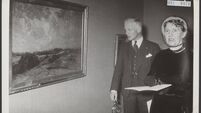Ancient fossil tale compelling
However, the case that the kitten-sized mammal was on our evolutionary line is compelling. It had opposable thumbs, just as we have, and its ankle bone was the same shape as ours.
Lucy, the most famous human ancestor, lived 3.2 million years ago. Less than 40% of her skeleton is intact, whereas 95% of this creature’s bones remain. The outlines of the fur and soft body parts are preserved and even the remains of the last meal were fossilised. Apart from the connection with humans, this Mona Lisa of palaeontology is the most complete fossil of an ancient primate ever found.
Tudge’s book begins in detective story format with a gripping main plot and an equally intriguing sub-plot. The hero of the narrative is Dr Jorn Hurum, a palaeontologist at Oslo’s Natural History Museum. In the hope of acquiring specimens, the staff of such institutions attend fairs where fossils are offered for sale. The really important items are never displayed openly at such gatherings, but information about them is circulated among potential buyers by word of mouth. At a fair in Hamburg in December 2006, Hurum was approached by a dealer named Perner, who showed him a photograph of a perfectly preserved fossilised primate. The identity of the finder was not disclosed, but Perner offered to arrange a ‘showing’ for Hurum, who was collected by car and whisked away, in cloak and dagger fashion, to a secret location where he saw the specimen which was to change his life.
The asking price for the item was more than a million dollars. Hurum, after several sleepless nights, managed to persuade his museum to come up with the money and the fossil, X-rayed and authenticated, was transported to Norway. A team of experts was assembled to work on the specimen. Two years later, they were ready to go public. The monkey-like creature had turned out to be a young female with milk teeth still intact. She was only a youngster when she died, so Hurum called her ‘Ida’, after his six-year-old daughter.
Ida’s remains had been found in a deposit of oily shale near the village of Messel, 35km south east of Frankfurt. The story of the pit from which she came is the sub-plot of Tudge’s book. Fifty million years ago magma, welling up from the bowels of the earth, heated an underground lake which flashed into steam creating a series of massive explosions. The crater filled with water to form a lake 1.6km wide and 100 metres deep. Surrounded by dense rainforest, noxious volcanic gases welled up from the lake bottom. The bodies of creatures falling foul of the gases sank into it and were preserved in sterile bacteria-free mud. In 1971, the German government decided to use the Messel Pitt as a dump and an access road was constructed to facilitate lorries. Fortunately, protests from scientists and heritage enthusiasts won the day. The Messel Pit is now recognised as one of the great fossil-finding locations. It was designated a World Heritage Site in 1995.
Hurum’s team carried out some extraordinary detective work on Ida. Her grasping hands and feet, and her long balancing tail, indicate that she was a squirrel-like tree-dwelling creature which lived on fruit and nuts. But how did an animal which spent its days in trees come to grief in a lake? X-ray analysis came up with an answer. Ida had suffered an accident and broken her right wrist. The injury had partly healed, but the scientists think that she could not climb very well. Forced to live on the ground, she probably approached the lake to drink. Then a dense layer of carbon dioxide covering the water surface smothered her. Unconscious, she fell into the pit, drowned and sank to the muddy bottom. That modern detectives could solve the riddle of her death, 47 million years after it occurred, is miraculous.
The Link; Uncovering our Earliest Ancestor by Colin Tudge is published by Little Brown, price £18.99.













